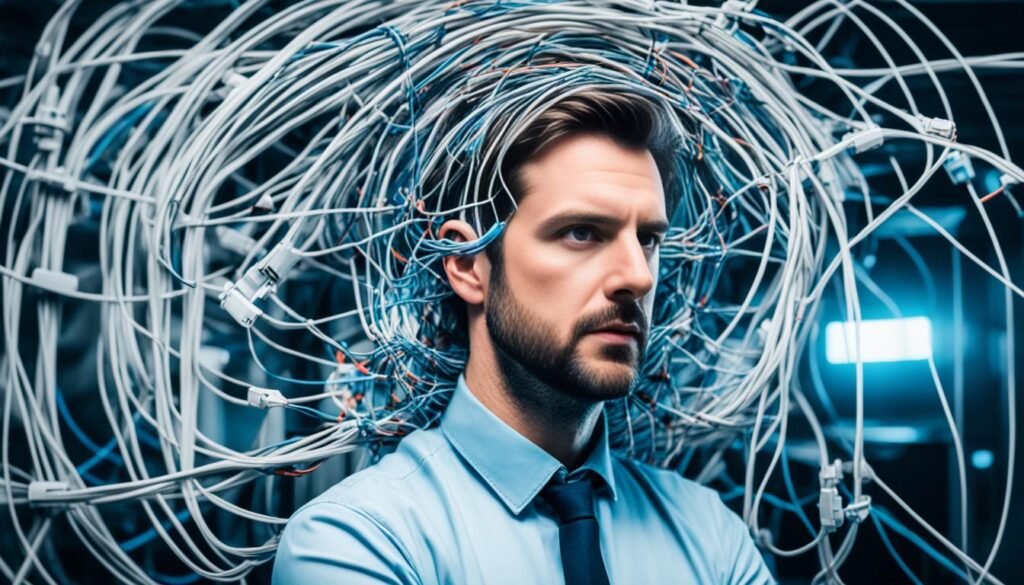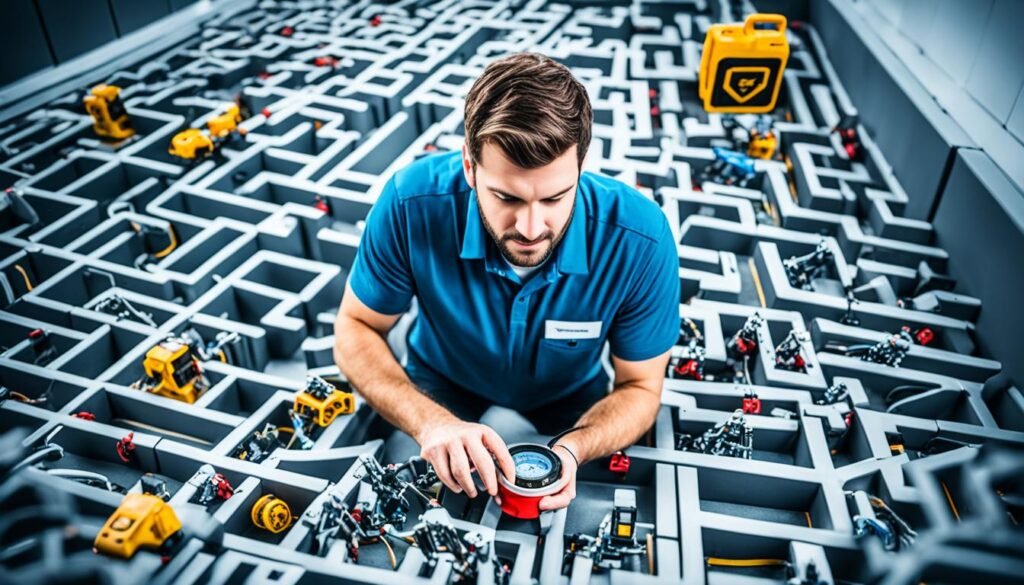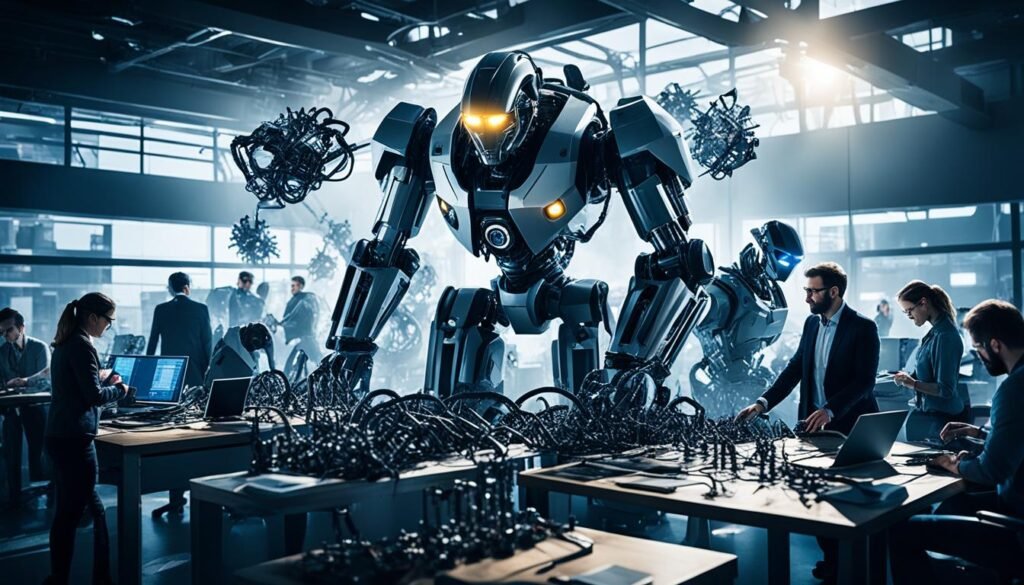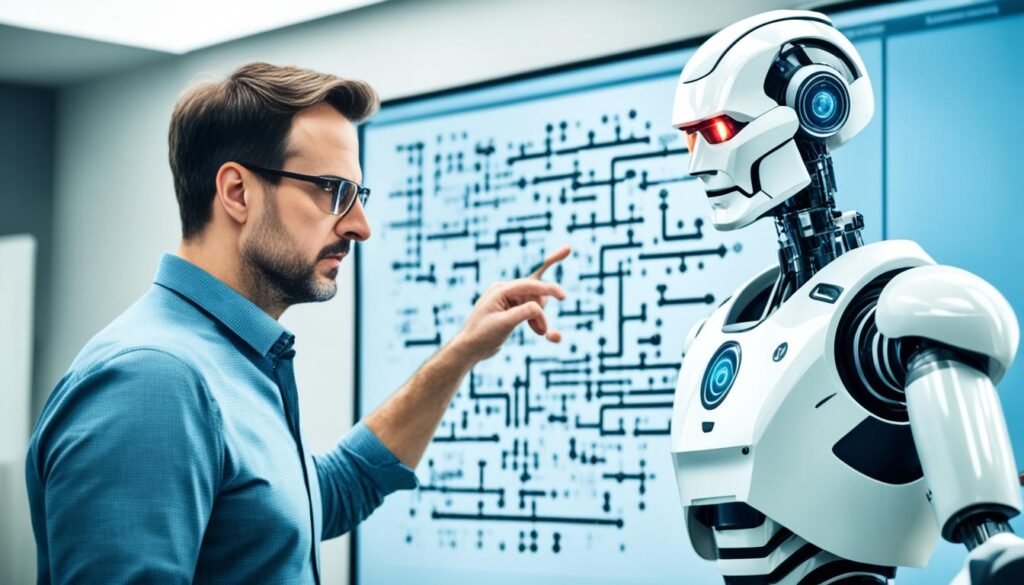Imagine a world where AI systems make big decisions in our lives, like in healthcare and law. But what if these AI tools were wrong? A recent survey by Forbes found over 60% of Americans trust humans more than AI in tasks like giving medicine and making laws. This shows we need to understand AI’s limits and use it carefully.
Generative AI tools like ChatGPT and image generators are becoming part of our daily lives. But, they can produce biased and wrong content. This happens because of problems with their training data, the way they’re designed, and their lack of human-like thinking. These AI mistakes can lead to serious issues, like spreading discrimination, giving wrong info, and affecting business choices.
Key Takeaways
- AI systems can make biased and wrong content because of problems with their training and design.
- AI mistakes can have big effects in real life, like spreading bias and giving wrong info.
- It’s important to use human judgment and oversight to check and use AI tools right.
- Using critical thinking, getting different sources, and setting clear rules are key to lessen AI risks.
- Creating and using AI responsibly needs a full approach that looks at technical, ethical, and legal sides.
As AI changes our world, it’s clear we must navigate its limits and use it responsibly. By knowing the risks and details of AI, you can make smart choices. This way, you can use AI’s power while keeping things fair, open, and accountable.
Biased and Inaccurate AI Outputs
Generative AI systems like ChatGPT and image generators can create biased and inaccurate content. This happens because of problems with their training data, model limits, and the nature of AI. These issues have been known for a while, thanks to the Gender Shades project. It showed that AI systems were better at recognizing male and lighter-skinned faces, especially failing darker-skinned females.
A 2023 study looked at over 5,000 images made with Stable Diffusion AI. It found that the AI made gender and racial stereotypes worse. This shows how serious these biases can be, making some groups more at risk of harm.
For instance, using biased AI in police tools could unfairly target certain groups. ChatGPT, an AI text generator, has also been shown to produce harmful and biased content in recent studies.
Inherent Challenges in AI Design
Generative AI models learn from a lot of internet data, which often has errors and biases. This leads to false information, known as “hallucinations.” For example, in the Mata v. Avianca case, ChatGPT made up data in legal research.
These systems try to guess the next word or sequence to make plausible content. But they don’t check if what they say is true. This means their answers might seem right but aren’t always accurate.
AI lacks the critical thinking and belief-forming abilities of humans. So, we must check their outputs carefully and compare them with trusted sources. This helps ensure the content is accurate and avoids biased or wrong information.
As generative AI becomes more common, we need to work on these issues. We must make sure these systems are used responsibly. This means having strong safeguards and oversight to stop biases and inaccuracies from spreading.
Causes of AI Inaccuracies and Biases
Artificial intelligence (AI) systems can sometimes produce false information and spread biases. This happens for several reasons, like the data used to train them, their design, and the limits of AI technology.
Biased and Inaccurate Training Data
AI models, including generative AI like ChatGPT and image generators, learn from a lot of internet data. This data often has inaccuracies and biases that mirror society’s own biases. So, when AI models copy these patterns, they can reproduce and amplify these biases and inaccuracies in their outputs.
Prioritizing Plausibility Over Truth
Generative AI models aim to predict the most plausible next word or sequence. They don’t always focus on creating truthful content. This can result in plausible-sounding but inaccurate information.
Limitations in AI Reasoning
AI systems can’t reason, reflect, or discern truth like humans do. They struggle to tell factual information from misinformation. This can lead to the creation of inaccurate and biased content.
| Cause | Impact | Example |
|---|---|---|
| Biased training data | Amplifying societal biases | Healthcare AI algorithms showing lower accuracy for Black patients |
| Prioritizing plausibility over truth | Generating plausible-sounding but inaccurate content | Applicant tracking systems exhibiting biased results in hiring |
| Limitations in AI reasoning | Inability to differentiate fact from fiction | Online advertising platforms displaying gender-biased job ads |
These causes show why AI inaccuracies and biases are a big deal. We need to think carefully before using AI. And, we must keep an eye on them to fix these problems.

Real-World Consequences of AI Errors
AI errors and biases can have serious effects in the real world. They can lead to discrimination and give out wrong information. This is true in law enforcement and legal cases, where AI’s limits need human oversight.
Amplifying Bias in Law Enforcement
Using biased AI in “virtual sketch artist” tools for police can harm certain groups more. For instance, a 2018 study showed that PredPol software predicted crimes in areas with more non-white and low-income people.
Misleading Information in Legal Cases
AI like ChatGPT can also cause problems in legal work. In the Mata v. Avianca case, an attorney used ChatGPT for research. But, the judge found that the AI made up some quotes and citations.
| Real-World Impact | Example | Consequence |
|---|---|---|
| Perpetuating Discrimination in Law Enforcement | Biased “virtual sketch artist” software used by police departments | Increased risk of harm, physical injury, and unlawful imprisonment for over-targeted populations |
| Providing Misleading Information in Legal Cases | Reliance on ChatGPT for legal research | Opinions containing fabricated internal citations and quotes, undermining the credibility of legal proceedings |
AI errors and biases have big implications for us. As AI becomes more common, we must be aware of its limits. We need to use AI responsibly to prevent discrimination and wrong information.
The Human Touch Remains Crucial
As AI becomes more common, we must remember the value of human touch. Humans can think deeply, form beliefs, and make complex judgments. This skill is key because AI can sometimes go off-topic or include wrong info due to its limits.
The AI market could hit $2 trillion by 2030. Almost 85% of top bosses think AI will help their companies stand out. But, we need to balance AI with human oversight and judgment. AI is getting better at recognizing patterns, catching fraud, and predicting trends. Yet, it still can’t match humans in creativity, emotional smarts, and adapting to quick changes.
It’s important to use AI for tasks that need repetition and don’t have high stakes. AI should not be used for complex decisions that require creativity or quick thinking. Being open about how AI works is key to avoiding errors and bias. These mistakes can lead to serious issues, like unfair treatment in law or wrong info in court cases.
The human touch is something AI can’t replace. We must check AI results carefully and use our own judgment. This means using our experience, gut feelings, and understanding of the situation. As AI grows, finding the right balance between tech and human insight is vital.
“Integrating AI with a human touch for decision-making is crucial, as AI may lack the ability to adapt to sudden changes or account for subjective insights.”
when ai is wrong
AI systems don’t think like humans do. They don’t have the ability to think deeply or form their own beliefs. They work only with the data they were trained on. This means their answers can sometimes be off-topic or include info that’s not needed. Deep learning models can make things seem right but might not truly understand the topic.
Humans are still the best at checking if AI’s answers are right. We need to be careful with AI’s work. We should check its info against trusted sources. AI mistakes, AI errors, AI inaccuracies, AI failures, AI flaws, AI limitations, and AI shortcomings happen often. We must be careful with them.
Evaluating AI Outputs with Human Judgment
AI can’t think like us or make up its own beliefs. We have to check their work carefully. It’s key to make sure AI’s answers are right. If we don’t, AI mistakes, AI errors, AI inaccuracies, AI failures, AI flaws, AI limitations, and AI shortcomings could cause big problems.
- AI can sometimes go off-topic or add info that’s not needed because of its limits.
- We should be careful with AI’s work and check it against trusted sources.
- Humans are still the best at figuring out if AI’s answers are trustworthy.
| AI Limitations | Real-World Impacts |
|---|---|
| Biased and inaccurate outputs | Can spread discrimination in law enforcement or give wrong info in legal cases |
| Lack of critical thinking and self-reflection | Can make content that seems right but is shallow |
| Brittleness and catastrophic forgetting | Can’t recognize objects or adapt to new info, leading to unpredictable actions |
Knowing what AI can’t do helps us use it wisely. We can handle when AI is wrong, AI mistakes, AI errors, AI inaccuracies, AI failures, AI flaws, AI limitations, and AI shortcomings better with care and attention.
Strategies to Mitigate AI Pitfalls
Generative AI tools like ChatGPT and image generators are getting better all the time. But, they have limits and risks we need to think about. Issues like hallucination, bias, and inaccuracy can cause big problems in real life. Luckily, there are ways to lessen these AI problems.
Critically Evaluate AI Outputs
It’s important to look at AI-generated content carefully. AI can’t think critically or have its own beliefs like humans do. So, we should check their work with our own judgment and compare it to trusted sources. This helps make sure the information is right and fair.
Diversify Your Sources
To avoid getting biased or wrong info, use many different sources. Look at what different AI tools say and check it against expert opinions and solid data. This way, you get a fuller picture of the topic.
Ensure Human Oversight
Even with AI’s great skills, we still need humans to keep an eye on things. Setting up strong rules, making sure people are accountable, and training AI users can help fix AI mistakes and biases.

“Evaluating AI outputs with human judgment and cross-referencing with reliable sources is essential to address the limitations and risks of AI.”
By using these strategies, we can make the most of AI while avoiding its downsides. A mix of AI and human know-how is the best way to use these powerful tools. This way, we can unlock the full potential of AI.
AI Accountability and Regulations
AI is becoming a big part of our lives, so we need strong rules and accountability. AI can make mistakes, show bias, or cause harm. This can hurt customer trust, damage a brand’s reputation, lead to legal trouble, and raise ethical questions.
Being accountable with AI means many people have to work together. This includes users, their bosses, companies, developers, vendors, data providers, and regulators. We need a strong plan to make sure AI is used right and fix any problems it might cause.
Legislation and Company Policies
Legislation helps keep everyone safe by setting clear rules and consequences for AI misuse. Company policies give a clear guide on how to use AI at work. These policies should cover AI accountability, AI regulations, and how to handle AI errors and AI biases.
| Regulations and Policies | Key Considerations |
|---|---|
| Legislation | – Establish clear accountability structures – Define responsibilities for all stakeholders – Outline legal consequences for AI misuse |
| Company Policies | – Provide detailed operational guidelines – Outline internal processes for AI deployment – Implement mechanisms for error detection and mitigation |
Strong AI accountability and AI regulations help build trust and reduce risks. They make sure AI is used responsibly.
“Responsible AI is not just a nice-to-have, it’s a must-have. Businesses and governments that fail to prioritize AI accountability and transparency will face serious consequences.”
The Promise and Peril of AI
Artificial Intelligence (AI) is changing many parts of our lives. It’s growing fast, like ChatGPT, which got 100 million users in just two months. This shows AI’s potential to make things more efficient and open new doors. But, there are also big risks and challenges we need to handle with care.
AI can make us work better and manage our time well. Research shows 61% of workers using ChatGPT got better at managing their time. And 57% said it made them more productive. This means AI can help us do our jobs faster and think more about strategy and creativity.
But, AI also has its dangers. The same tech that makes things more efficient can risk our data. For example, 3.1% of workers shared secret info with ChatGPT, which could be a big mistake. Also, 20% of employees used ChatGPT at work without their bosses’ okay, showing we need clear rules for AI use.
In schools, AI tools like ChatGPT and Microsoft Co-Pilot are causing worries about cheating and privacy. Some students feel their homework lacks purpose, which might make them lose interest in learning. Yet, AI can help teachers with tasks like planning lessons and reporting, easing their workload.
The good and bad sides of AI affect many areas, not just work or school. As AI gets better and more common, we must keep checking on it and make sure it’s used right. We need everyone – leaders, policymakers, and the public – to work together. This way, we can enjoy AI’s benefits while avoiding its risks.
| Promise of AI | Peril of AI |
|---|---|
|
|
As we see the ups and downs of AI, it’s clear we need to handle it carefully. By understanding both sides, we can use AI in a way that helps society. This means enjoying its benefits while keeping our values and well-being safe.

AI’s Limitations in Human Judgment
AI technology is getting better, but we must see its limits, especially in mimicking human judgment. AI is great at analyzing data and spotting patterns. Yet, it can’t fully grasp the complex way humans make decisions. This is because our choices are influenced by our experiences, gut feelings, values, and understanding of the situation.
Experience is a big factor that makes human judgment different from AI. Experts in fields like medicine, law, or business have a lot of knowledge that AI can’t match. They use their past experiences, notice details AI might miss, and make quick, smart decisions. This shows how deep and complex human thinking is.
Also, human judgment is shaped by our personal values and ethics, which are hard to put into AI. For instance, a doctor’s decision isn’t just about the data. It also includes understanding the patient’s situation, their wishes, and the right thing to do ethically.
Human judgment is also shaped by the situation itself. AI can handle lots of data but might not get the complex and changing parts of real life. This can make AI decisions seem right but miss the important details needed for good decisions.
“AI can assist in many tasks, but it cannot replicate the depth and breadth of human judgment, which is rooted in our unique experiences, values, and understanding of the world around us.”
We need to understand AI’s limits as we use it more in our lives. It’s important to value human judgment and keep a watchful eye. This way, we can use AI’s strengths while avoiding the dangers of relying too much on technology.
The mix of AI and human judgment is complex and always changing. We must keep exploring and thinking carefully about it. It’s key to use AI in a way that respects human skills and judgment, making sure it adds to our abilities, not replaces them.
The Importance of Human Oversight
In the world of artificial intelligence (AI), human oversight is key. It ensures fairness, transparency, and accountability. AI can make things more efficient and help with decision-making. But, it can’t think like humans do, making nuanced judgments or understanding context.
AI has risks and challenges that highlight the need for human oversight. AI can give biased, wrong, or misleading answers because of its training data, model limits, and AI design challenges. Without human judgment, these problems can lead to serious issues, like discrimination or wrong info in legal cases.
Human oversight is vital for checking AI outputs and making sure they’re right. This oversight reduces AI risks, cuts bias, ensures good data, and makes the output more accurate. Regular checks, data quality reviews, and feedback from users are key to good oversight.
Also, human oversight makes AI systems clearer and easier to understand. Tools like LIME and SHAP help show how AI models work and why they make certain decisions.
In conclusion, the role of human oversight in AI is huge. By using human judgment with AI’s power, we can make the most of these technologies safely. This teamwork is crucial for making sure AI is fair, clear, and responsible in real life.

“AI should augment human capabilities, not replace them entirely. The human touch remains crucial in evaluating and overseeing the responsible use of AI.”
Conclusion
AI has great promise but also big risks and challenges. It can make things more efficient and help with decisions. Yet, it can’t replace human judgment or fully understand human feelings.
To use AI well, we must focus on responsible development. This means fixing bias in algorithms and protecting privacy. It also means following ethical guidelines and making rules that help society and innovation work together.
By doing this, we can use AI’s power for good. As AI gets better, we must stay careful and thoughtful. This way, we can make the most of AI without its downsides.
The future of AI depends on our choices now. If we work together and keep human values in mind, AI can change the world for the better. It’s a tricky balance, but it’s key for a future where tech and people work together well.
FAQ
What are the potential issues with generative AI tools like ChatGPT and image generators?
Generative AI tools can create biased and wrong content. This happens because of problems with their training data and model limits. They might spread biases about gender, race, and more. Their results could be false or not relevant.
Why do AI systems generate biased and inaccurate content?
AI systems can make false information and increase biases. They learn from data that has errors and biases. They aim to create believable content, not true content. They also can’t think or reason like humans do.
What are the real-world consequences of AI errors and biases?
AI’s biased and wrong outputs can cause big problems in real life. For example, they can make discrimination in law enforcement worse. They can also give wrong info in legal cases, harming already vulnerable groups.
Why is human oversight and judgment still crucial when using AI?
AI can’t think deeply or form beliefs like humans do. So, we need to check their outputs carefully. We should compare them with trusted sources to make sure they’re right and fair.
What strategies can be used to mitigate the issues of hallucination and bias in generative AI tools?
To fix AI’s problems, we can check AI results carefully, use different sources, and have humans review them. We also need rules, laws, and company policies to use AI responsibly.
How can AI be used responsibly and ethically?
To use AI safely and right, we must focus on its responsible development and use. We should work on fixing bias in algorithms. We need to be open and accountable. Protecting privacy is key. We should follow ethical rules and have laws that help innovation and protect society.
